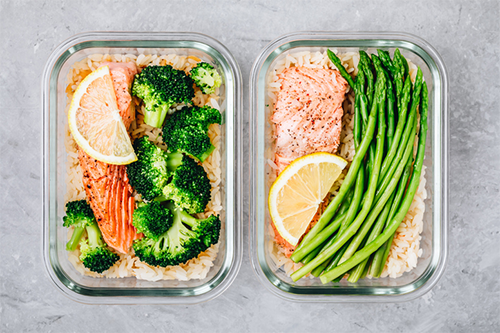
How Much Muscle Can You Gain in a Month?
By Jenessa Connor
Want to know how to identify a fitness pro who's knowledgeable and trustworthy? Ask them how much muscle you can gain in a month. If they give you any answer other than "it depends," work with someone else.
In a world that values fast results and quick fixes, it's natural to wonder just how soon a training plan will start to yield visible results. But hypertrophy — or the growth of skeletal muscle fibers — is a complicated equation with multiple variables. Biological sex, genetics, nutrition, training, sleep habits, and current fitness level all play a role.
“To say how much someone will gain is an impossible question to answer," says Todd Buckingham, Ph.D., chief exercise physiologist at The Bucking Fit Life, a wellness coaching company. "I couldn't even answer that question for myself, to be honest." And if someone does quote you a specific quantity of pounds or inches? “They're full of it!" jokes Buckingham.
While no one can accurately predict how much muscle you can gain in a month, you can use what we know about muscle growth to optimize your training and lifestyle to work toward your body composition goals. Here's what you need to know.
Build muscle and enhance recovery with LADDER Whey or Plant Protein.
.
How Muscle is Formed

Hypertrophy is the body's way of adapting to new or increased stimuli, explains Buckingham. “When you do any type of resistance training, the muscles get micro tears in their fibers," he says. “Your body has to repair and rebuild those micro tears in the fibers to make them bigger and stronger, so that the next time that you do the same activity or lift the same weight, your muscles don't get damaged as much as they did the last time."
Metabolic stress, which you achieve by working your muscles to the point when "metabolic waste" (a byproduct of energy production) accumulates faster than it can be removed, also triggers a hypertrophy response. But where does the balance lie between mechanical stress (i.e., micro-damage of muscle fibers) and metabolic stress when it comes to building lean mass?
According to research from one of the leading exercise scientists, Brad Schoenfeld, Ph.D., CSCS, "mechanical and metabolic stress occur in tandem, making it difficult to tease out the effects of one from other."
What we do know is that actual muscle building happens between workouts when your body is at rest. “While you're lifting, you're actually breaking down your muscle, but it's afterward that it gets built up," Buckingham says. What's more, the hormones that facilitate muscle growth are mostly released at night. "That's why sleep is really important for increasing muscle size," he adds.
.
How Quickly Can You Gain Muscle?
While muscle growth happens at night, it certainly doesn't happen overnight — several factors affect how quickly you can gain muscle. And while you might be focused on improvements in muscle at the start of a new fitness program, the most significant gains are actually happening in your nerves.
“In the first eight to 12 weeks of beginning a strength-training program, the most impactful factor in improving your strength is neural adaptations," Buckingham says. “Your nervous system becomes more efficient at sending messages from your brain to your muscles and recruiting more of the correct muscle fibers."
Buckingham likens it to completing a maze. The first couple of times you attempt it, you're going to hit dead ends. But, over time and through repetition, you eventually learn the quickest path.
“Lifting and recruiting muscle fibers is kind of the same thing," he says. At first, your nervous system may recruit too many muscle fibers or the wrong muscle fibers altogether, but it eventually learns the quickest, most accurate path. And that's when hypertrophy starts to become measurable.
So, if you see little to no difference in your muscle size after a month of training, don't quit! Your body is changing — you just can't see it yet.
.
Factors That Affect Muscle Growth
Factors within and beyond your control determine how much muscle you can gain in a month (or any period of time). When setting any body composition goals, it's important to consider the following.
1. Genetics

Here's the unfair truth about genes and muscle mass: You can follow the same diet, training program, and sleep schedule as someone else and experience entirely different results. Some research suggests heredity accounts for 50 to 80 percent of your muscle mass.
Also, men tend to gain more muscle at a faster rate than women. “That's primarily due to testosterone and growth hormone," Buckingham says, since women have less. But research also shows that strength gains by women are typically similar to those achieved by men, meaning that they're able to build braun without adding bulk.
2. Age
As we age, our anabolic hormone levels decrease, making it more challenging to gain muscle. Even the most dedicated lifters will eventually experience sarcopenia, a loss of muscle mass, later in life.
“Strength training will help preserve some of that muscle mass, but it's inevitable that, even if you continue lifting for the rest of your life, your muscle mass is going to decrease."
3. Diet and Nutrition

Most people understand that protein is necessary for repairing and recovering muscle. The other macronutrients — carbohydrates and fat — are also essential, as they're integral to recovery and hormone production (among other physiological processes). Plus, you need adequate carbohydrates to fuel your training.
Buckingham also notes that you must be in a caloric surplus to build muscle. “A lot of people want to lose weight but also gain muscle size, and that's just not going to happen because, in order to gain muscle, you need to have extra calories."
4. Rest and Recovery
“Sleep is where you release hormones that cause muscle growth," Buckingham says. "So if you're not sleeping enough, then you're not causing those hormones to be released."
Aim to get at least seven hours of sleep a night, and incorporate recovery time between workouts by periodizing your training and scheduling rest days. “If you're constantly lifting and never giving your muscles a break, then they don't have time to repair, rebuild, and grow," he says.
5. Training

The way you structure your exercise program is hugely influential on your muscle growth, and thankfully, it's something you can calibrate according to your goals. A certified fitness pro can help you create a periodized training plan that works for you. But, generally speaking, you want to hit every muscle group a couple of times a week (with recovery time interspersed), and your load should typically be heavy.
“Three to four sets of eight to 10 repetitions at 75 to 85 percent of your one-rep max," Buckingham says. "That's going to give you the most bang for your buck."
.
The Best Exercises for Rapid Muscle Growth
For hypertrophy, Buckingham recommends focusing on compound (multi-joint) lifts that target large muscle groups. Below are some go-to exercises.
1. Barbell Front Squat

- With the barbell resting on a squat rack, grip the bar with your hands shoulder-width apart. Bring your shoulders underneath the barbell so that your elbows are bent and facing forward, and the bar is resting on the underside of your palms or fingers across the top of your shoulders.
- Step back, lifting the bar out of the rack, and stand tall with your feet slightly wider than shoulder-width apart. This is the starting position
- Keeping your back flat, chest up, and core braced, push your hips back, bend your knees, and lower your body until your thighs are at least parallel to the floor.
- Pause, and then push through your heels to return to the starting position.
2. Romanian Deadlift
- Stand with your feet hip-width apart, holding a pair of heavy dumbbells or a barbell in front of your thighs, palms facing you. This is the starting position.
- Keeping your back flat, shoulders back, and core engaged, push your hips back and keeping only a slight bend in your knees, lower the weight along the front of your body to mid-shin level.
- Pause, and then slowly reverse the movement to return to the starting position.
3. Dumbbell Bench Press

- Lie on a flat bench holding a pair of dumbbells directly above your chest with your palms facing forward. Your head, upper back, and butt should touch the bench, and keep your feet flat on the floor. This is the starting position.
- Keeping your core engaged, slowly lower the weights to the sides of your chest, keeping your elbows close to your body (your upper arms and the sides of your torso should form a 45 degree angle at the bottom of the movement).
- Pause, and then push the weights back up to the starting position.
4. Dumbbell Bent-Over Row

- Stand with your feet hip-width apart, holding a dumbbell in each hand. Brace your core, push your hips back, bend your knees slightly, and lower your torso until it's nearly parallel to the floor. Keep your glutes engaged to protect your lower back.
- Let the dumbbells hang at arms' length with your palms facing each other. Engage your shoulder blades to keep your shoulders pulled back. This is the starting position.
- Without moving your torso, and while keeping your elbows tucked and back flat, row the weights to the sides of your ribs as you squeeze your shoulder blades together. Make sure there's a 90-degree bend in the elbow, so you're rowing to your ribs and not armpits.
- Pause, and then lower the weights back to the starting position.



